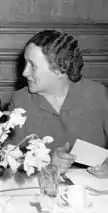Hilda Ingold
Edith Hilda, Lady Ingold (née Usherwood; 21 May 1898 – 1988) was a British chemist based in Leeds and London. Her career was unfairly overshadowed by that of her husband. She failed to gain much public recognition, despite being an innovative chemist and partner to her husband in his work on organic chemistry.[1][2] She was known as Lady Ingold following her husband's knighthood.
Edith Hilda, Lady Ingold | |
|---|---|
 | |
| Born | Edith Hilda Usherwood 21 July 1898 |
| Died | 1988 (aged 89 or 90) |
| Nationality | British |
| Alma mater | Imperial College London |
| Spouse | Sir Christopher Kelk Ingold |
| Children | 3 |
| Scientific career | |
| Fields | Chemistry |
| Institutions | Imperial College London |
| Doctoral advisor | Martha Whiteley |
Early life
Edith Hilda Usherwood was born into a working-class family in Catford (south-east London).[3]
Education
She attended a girls' grammar school in Lewisham, and then had two years of private education in Horsham. She then moved to the North London Collegiate School after being awarded a Clothworker's Scholarship.
As an undergraduate at Royal Holloway College, Usherwood attained a BSc Hons in Chemistry (1916-1920) before completing her doctorate in 1923 at Imperial College London. As the doctoral degree was only introduced to British Universities in 1917[4] she was one of the earliest students to qualify. Her PhD project was on tautomers, isomers of molecules which differ only in the position of a labile hydrogen atom. Her doctoral supervisor was Martha Whiteley.[5]
Her subsidiary subject was physics and this led to her research in physical organic chemistry and quantum mechanics.[3] Following completion of her PhD she went on to complete a DSc.
She was president of the UCL Chemical and Physical society during the 1976-1977 academic year, one of the oldest and most prestigious societies at the university.
Personal life
She married fellow Chemistry student Christopher Kelk Ingold in 1923 and went on to have three children. They had two daughters and a son, the chemist Keith Ingold.[6]
References
- William Hodson Brock (2011). The Case of the Poisonous Socks: Tales from Chemistry. Royal Society of Chemistry. pp. 218–. ISBN 978-1-84973-324-3.
- Jed Z. Buchwald; Andrew Warwick (2004). Histories of the Electron: The Birth of Microphysics. MIT Press. pp. 347–353. ISBN 978-0-262-52424-7.
- Anne Barrett (24 February 2017). Women at Imperial College: Past, Present and Future. World Scientific. pp. 89–. ISBN 978-1-78634-264-5.
- "100 Years of the PhD in the UK" (PDF). Vitae.ac.uk. Retrieved 9 April 2018.
- Henry, Rzepa (13 November 2011). "The dawn of organic reaction mechanism: the prequel". Henry Rzepa. Retrieved 1 November 2017.
- Nye, Mary Jo (1994). From Chemical Philosophy to Theoretical Chemistry. University of California Press. pp. 197–198. ISBN 978-0-520-08210-6.